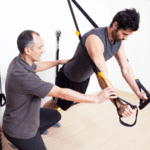
Mom my finger hurts! Mom my leg hurts! Mom my foot hurts! Sometimes it’s hard to know what pain we need to worry about and what pain a moms kiss can cure. Today we are going to talk about pediatric foot pain, what we can do to help prevent it and what to do if pain is present.
Foot pain is a common complaint among children. Children may complain of foot pain on the bottom of the foot, on either side of the foot, at the bottom of the heel, at the back of the heel and up into the calf. This pain can be common when running, jumping, going up or down stairs, walking and standing. The pain may get worse with prolonged activities and be present for some time after rest. Foot pain may come from tightness of the ankles, a large growth spurt, or sports injury.
Often kids may get tight ankles from walking on their toes. When we walk on our toes we develop very strong and tight calf muscles (gastrocnemius and soleus). When these muscles are tight it limits the ability to dorsiflex the ankle comfortably making it difficult to walk and run normally without pain. When a child gets a growth spurt this can also increase tightness at the muscle/tendon attachment to the bone causing inflammation and pain. Active children who participate in running and jumping sports can get overuse injuries that may include tendonitis, Sever’s disease, and plantar fasciitis.
If we notice our child walking on their toes the first thing we can do is try and teach them to walk heel to toe. This sometimes takes a lot of patience and consistent reminding. Another thing we can do is stretch out their ankle. If your child is small you can lie them on their back or belly and bend their legs and feet stretching the ankles. If your child is older you can teach them stretches to keep their muscles loose. See pictures below for examples of stretches to do with your child. Keeping the muscles and joints mobile could help keep pain away.



If your child does have pain that is not improving or is worsening it is recommended to seek medical care so that the injury does not worsen or cause further damage. There are several options to seek out. You can follow up with your pediatrician, contact a podiatrist or contact a physical therapist directly for assessment. A physical therapist can evaluate your child’s injury and recommend continuing with physical therapy or seeing an MD if necessary. Physical therapy will work to improve any imbalances in the lower extremity to reduce mechanical overload, improve tissue integrity and reduce symptoms.



